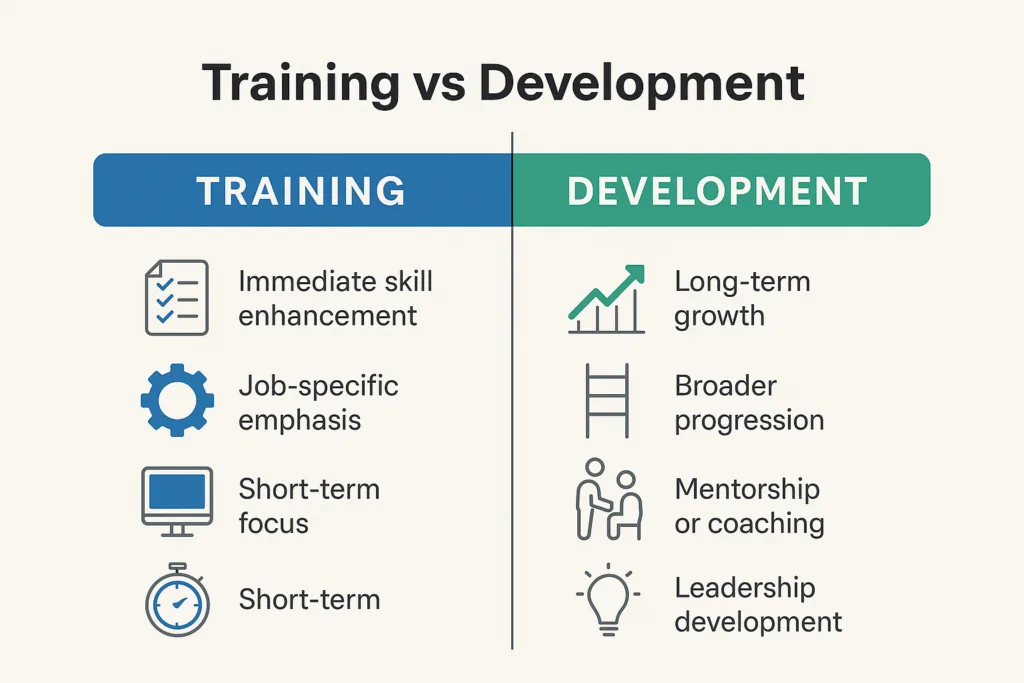The success of any organization is intricately linked to the growth journeys of each individual team member. While often grouped together, “training” and “development” represent distinct approaches to supporting employees’ potential. Recognizing the specific purpose of each—training for immediate skill enhancement, development for long-term career progression—and strategically leveraging both is crucial for maximizing short-term impact and fostering enduring commitment within our workforce.
In this post, we’ll clearly define the distinct roles of training and development, explore practical scenarios for their effective implementation, and provide a framework for building a cohesive talent development strategy that benefits both our valued employees and the organization as a whole.
What is Employee Training and Development?
You may be asking yourself, what is training and development in the context of today’s modern workplace? Think of it this way:
Employee training is the process of imparting specific skills, knowledge, or behaviors to employees to enhance their immediate performance and productivity in their current roles. It’s typically structured and involves clearly defined objectives and outcomes.
Employee development is the process of fostering broader skills and competencies in employees to prepare them for future roles, challenges, and leadership opportunities. Development is more about supporting long-term career growth, self-improvement, and organizational alignment over time.
Both are essential, but while training addresses immediate needs, development helps employees grow beyond their current positions to take on more strategic roles.
Training vs Development: What’s the Difference?

The Objective of Training
At its core, training is designed to improve specific skills or knowledge in the short term. This typically addresses an immediate need, such as teaching employees how to operate new software, understand company policies, or follow safety procedures. The main objective of training is performance enhancement and ensuring employees have the necessary skills to perform their current job tasks effectively.
Training focuses on immediate, job-specific skills and typically takes a short-term, task-oriented approach. The outcome of training is improved employee performance and competency in day-to-day tasks. Methods used for training may include workshops, seminars, e-learning modules, or simulations.
For example, a new hire might undergo training to learn how to use the company’s project management software or be trained on compliance-related topics. This ensures they’re ready to contribute effectively from day one.
The Objective of Development
On the other hand, development focuses on long-term growth and career progression. It’s designed to prepare employees for future roles, enhance their broader skill sets, and support personal and professional growth beyond their current job responsibilities. While training targets specific skills, development takes a more holistic view, nurturing employees’ capabilities over time to support organizational growth.
Development focuses on long-term career growth and leadership development, taking a growth-oriented approach. The outcome of development is an enhanced career trajectory, improved leadership capabilities, and a stronger contribution to the organization. Methods for development include mentorship programs, coaching, cross-functional experiences, and leadership training.
For example, offering a leadership development program to employees who have expressed interest in management allows them to build the necessary skills and confidence to transition into leadership roles.
When to Use Training vs. Development
A balanced strategy that integrates both training and development is essential for employee engagement because it meets both immediate performance needs and long-term career aspirations. Training provides the essential skills and knowledge for excelling in today’s responsibilities, fostering confidence, competence, and a tangible boost in productivity. Development, however, focuses on preparing employees for future roles and broader contributions, giving them a sense of purpose and direction. When employees feel supported in their day-to-day responsibilities and see clear opportunities for growth, they’re more likely to stay engaged, motivated, and loyal.
Without balance, organizations risk burnout, stagnation, or disengagement—training alone may feel transactional, while development without proper training can leave employees unprepared. A unified strategy ensures your learning and development efforts are inclusive and aligned with both individual goals and business outcomes. It fosters a learning culture where employees feel valued, empowered, and connected to the organization’s long-term vision.
The Employee Training and Development Process: A Unified Framework
To build a robust training and development program, organizations need a clear framework that combines both aspects seamlessly. Here’s a step-by-step approach to creating a comprehensive process that supports both short-term performance and long-term employee growth:
Step 1: Start with Skills-Based Training
Training should always be the foundation. Begin by identifying the skills your employees need to perform their jobs efficiently. This includes both technical skills (such as using software tools) and soft skills (like communication and teamwork). Once these skills are defined, you can tailor your training programs to address specific needs, ensuring that employees are equipped to meet job demands immediately.
Example: Implement onboarding training that covers essential software, procedures, and company policies for new hires.
Step 2: Identify Long-Term Growth Paths
Once the basics are covered, shift focus to employee development by identifying career growth paths for employees. This step requires understanding their aspirations and potential within the company. Providing opportunities for continuous learning and exposure to different roles will nurture their leadership potential and broaden their skill sets for future success.
Example: Offer mentorship programs or stretch assignments that allow employees to gain experience in different areas of the company.
Step 3: Introduce a Blend of Learning Methods
The most effective learning experiences combine multiple approaches to create a well-rounded, engaging environment. For instance, mentorship or peer learning encourages knowledge sharing and leadership development by fostering relationships between colleagues and senior leaders. Project-based learning offers opportunities to tackle real-world challenges, giving employees hands-on experience that builds confidence and capability. For building soft skills and leadership development, personalized video content is another powerful tool, as it allows companies to scale training without relying on a dedicated video team.
These cross-functional experiences expose employees to different areas of the business, expanding their understanding of how the organization operates and encouraging a more collaborative mindset.
Example: Launch a cross-functional learning sprint where employees from marketing, product, and customer success work together to solve a real business challenge. This approach enhances collaboration, nurtures problem-solving skills, and helps employees build a broader, more strategic perspective.
Tracking Progress and Iterating Your Training and Development Plan Over Time
Effective training and development are ongoing processes. It’s essential to track employees’ progress to ensure they’re gaining the skills and experiences necessary for their development. Regular assessments, feedback, and surveys will help you identify areas for improvement and ensure that your training and development programs evolve to meet changing needs.
Key metrics to track:
- Training completion rates and effectiveness
- Employee engagement and retention
- Performance improvements over time
- Career progression and internal mobility
By tracking progress and refining the process, you can ensure your training and development programs stay relevant and impactful.
Training and Development: Bringing It All Together
Ultimately, training and development are both vital components of a modern workforce strategy. Training focuses on immediate skill acquisition, while development prepares employees for future roles and long-term success. When implemented together as part of a unified approach, they not only address the needs of the business today but also ensure that your employees grow, thrive, and stay engaged in the long run.
By balancing training with development, organizations can foster a learning culture that supports both immediate performance and future potential.
Ready to modernize your training and development process?
With SundaySky, you can create personalized, scalable video content that supports both onboarding and long-term employee growth—no video team required. Schedule a demo today!



